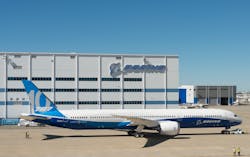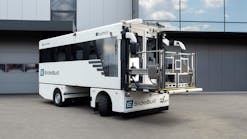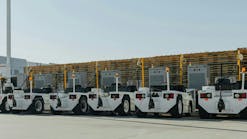Electrification and E-Flight Part 4 Boeing Is on the Way to a (More) Electric Future
Electric-flight and Boeing are words which nowadays go together; just a few years ago it was different and those words were seldom put in a direct relation. Boeing, as the big player in the airliner market started early with the More Electric Aircraft (MEA) but electric flight came into its vocabulary only recently and with a different approach as the direct rival Airbus. The E-flight movement has recently gained momentum and Boeing is now a solid part of that trend.
In the Early Days
Since the early days of the aircraft era, non-propulsive aircraft systems such as actuation, deicing and air-conditioning were depending on mechanical, hydraulic, and pneumatic sources of power. The aircraft engines have traditionally powered those systems; the power was extracted via a variety of mechanisms. Hydraulic and electric systems were powered via a mechanical linkage through the engine gearbox, whilst pneumatic power was generated using turbine air bleed systems.
Modern aircraft evolved over time - achieving radical increase in range, capacity, and speed - and the complexity of their systems increased accordingly. Hydraulic power is robust and generates large forces, but these systems have often suffered from a lack of reliability and high maintenance costs. Pneumatic systems have the drawbacks of low efficiency and are similar to hydraulic systems, with many miles of complex, heavy pipes and ducting running throughout the aircraft. Leaks in both systems were and are difficult to locate and are time-consuming to repair. Any interruption in normal operation may ground the aircraft until the issues are resolved, generating costs and inconvenience for operators and passengers alike.
MEA - A Solution to Traditional Problems
Well-designed electrically powered systems do not suffer from many of the shortcomings inherent to hydraulic, pneumatic, and mechanical systems described above. Electrical systems are relatively flexible and lightweight, and have higher efficiency. Over the years and decades more electric power was designed in and used in commercial aircraft.
A milestone in the trend toward the MEA was the introduction of the fly-by-wire in the Airbus A320 in the late 1980s, soon followed by the Boeing 777 in 1994. The MEA technology significantly reduced weight, creating additional space for other aircraft components. The electrical transmission of steering inputs from the cockpit to the flight control surfaces eliminated mechanical linkages.
Boeing set another - probably the most important - milestone with the 787. It was the very first large commercial aircraft with an electrically powered environmental control system, which additionally featured electrically actuated brakes and electrical deicing. Although the 787 still has a relatively conventional hydraulic system, the pressure in the system is generated by electrically powered hydraulic pumps.
Boeing, the MEA Pioneer
The development of small electric aircraft has been accompanied by technological upgrades to larger commercial aircraft in which electrically powered systems have been used to replace equipment previously powered by bleed air from the engines, including cabin pressurization, air conditioning, and deicing. Electric power is also being used to replace pneumatic and hydraulic systems, such as flight controls, brakes, and landing gear. Electric motors can also be used to power wheels to enable an aircraft to perform its own pushback and taxiing without the need for an external tug. One of the major pioneers of these ‘more-electric aircraft’ systems has been the Boeing 787 which uses electric systems to replace those previously powered by hydraulics or bleed air from the engines.
787 No-Bleed Systems
The Boeing 787 Dreamliner introduced a unique no-bleed systems architecture that eliminated a traditional pneumatic system and bleed manifold, converting the power source of most traditionally powered bleed air functions to electric power. According to Boeing, using electrical power is more efficient than engine-generated pneumatic power systems. This architecture extracts as much as 35 percent less power from the engines on the 787. Bleed air is only used for engine cowl ice protection and pressurization of hydraulic reservoirs.
Because the 787 uses more electricity than other Boeing airplanes, the 787 generates more electricity, using six generators: two on each engine and two on the APU in the tail section.
Image #2
On the ground, the 787 can be started without the use of ground power. The APU battery starts the APU generators, which start the APU to power the engine generators, which then start the engines.
In flight, the four engine generators are the primary sources of electrical power; the APU generators are secondary. Power runs from the generators to four alternating-current (AC) buses, where it is either distributed for use or converted to what other systems need.
Other power sources for the 787 include the main battery, used primarily for brief ground operations and braking; the APU battery, which helps start the APU; and ground power, which can connect through three power receptacles. The main battery, APU battery, and ram air turbine also are available as backup power in flight.
Batteries and Battery Safety
The 787 includes many layers of redundancy for continued safe operation. Boeing designed the systems so that no single failure will cause an accident by including redundant systems, separating systems in space and functions, and providing standby and protective systems.
The 787 Dreamliner has two primary rechargeable batteries – the main ship and APU. While identical part numbers, they serve separate purposes. Boeing selected the lithium-ion type battery because it is capable to deliver a large amount of power in a short period of time.
The 787 completed 5,000 hours of flight testing and an equal amount of test time on the ground prior to entering service. No battery-related incidents occurred before January 2013, when the airplane experienced two events and lessons learned improved the aircraft health.
A Different Approach to E-Flight
The two industry giants in the commercial aviation world took somewhat different approaches toward E-flight. Airbus started this E-flight journey a decade ago with single seat aircraft and is investing strongly in Urban Air Mobility field (see the March 2018 issue).
Boeing has chosen a different approach by investing its venture capital arm HorizonX in finding promising startups to invest often along with partners, including the Zunum regional aircraft programs.
Zunum Aero, a Seattle-based startup backed by Boeing and JetBlue Technology Ventures, announced in October 2017 plans for its first hybrid-electric plane, a 19-seater, which is optimized for a 700-nm range claiming a competitive price of about 8 cents per seat mile, or $250 an hour. The prototype should fly by 2020 and be certified under the revamped FAR Part 23 rules. The company hopes it can disrupt the regional airline industry, which it says is worth $1 trillion worldwide.
Zunum has been working since 2013 but in April 2017 announced hybrid or electric air travel on airplanes from 10 to 50 seats by the early 2020s. The company says it will start with the 19-seater, which could be reconfigured to a six- or nine-seat (jet-alike) aircraft.
Zunum hopes to bring a first hybrid-electric commuter aircraft to market by 2022, hoping to cut travel times on regional routes in half and emissions by 80 percent. Zunum hopes to produce bigger planes that can fly up to 1,000 miles by 2030. This implies battery-technology advances beyond what is now available.
The E-MRO and E-Mechanic
The aircraft mechanic, technician, or engineer of today has become much more of an electrician than decades ago. As you read through this issue of AMT you will hear from industry and academia about today’s challenges with training and certification of our workforce.
Let’s consider for a moment what knowledge and skills the maintainer of these future electric aircraft will need. Where will these maintainers come from? How will they be prepared, trained, and who will train them? What type of certification will they need to acquire and from which regulatory agency?
Consider the capital expenditures of the maintenance organization maintaining electric aircraft. What new types of tooling and equipment, and facilities will be necessary for the MRO to maintain the new technology of electric aircraft? These are very interesting questions and exciting to think about.
Until then, stay tuned. The Electrification and E-Flight movement is coming soon – or is already here.






